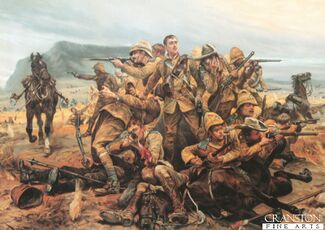Vozhsk War of Independence: Difference between revisions
mNo edit summary |
No edit summary |
||
| Line 41: | Line 41: | ||
}} | }} | ||
The '''Vozhsk War of Independence''' ({{wpl|Dutch language|Dutch}}: ''Voshaanse Vrijheidsoorlog''; {{wpl|Belarusian Language|Vozhsk}}: ''Vajna za Niezaliežnasć Vozhska'' ), more commonly known in Atmora as the '''Second Voshan War''' ({{wpl|Dutch language|Dutch}}: ''Tweede Voshaanse Oorlog''; {{wpl|Belarusian Language|Vozhsk}}: ''Druhaja Vozhskaja Vajna'' ) was the penultimate phase of the Vozhsk national liberation conflict. It was fought between the [[Atmora|Atmoran Empire]] and the Vozhsk Democratic Federative Republic, backed by international allies. | The '''Vozhsk War of Independence''' ({{wpl|Dutch language|Dutch}}: ''Voshaanse Vrijheidsoorlog''; {{wpl|Belarusian Language|Vozhsk}}: ''Vajna za Niezaliežnasć Vozhska'' ), more commonly known in Atmora as the '''Second Voshan War''' ({{wpl|Dutch language|Dutch}}: ''Tweede Voshaanse Oorlog''; {{wpl|Belarusian Language|Vozhsk}}: ''Druhaja Vozhskaja Vajna'' ) was the penultimate phase of the Vozhsk national liberation conflict. It was fought between the [[Atmora|Atmoran Empire]] and the Vozhsk Democratic Federative Republic, backed by international allies. On the Vozhsk side, most combatants were members of underground republican militias, foreign volunteer legions, or expeditionary forces from foreign governments. Against them were the Atmoran military, as well as the forces of Atmoran dominions and states in personal union, as well as loyalist Vozhsk constables of the KVPD. It was an escalation of the 'Smutny', the severe revolutionary nationalist unrest that characterised the period of 1883-1911. | ||
In October 1904, Vozhsk republicans of the Peasant-Labour and National parties launched the Autumn Revolt against Atmoran rule. Although the revolutionaries managed to seize Mohilev and several major towns on the island of Luhan, the uprising was crushed within a fortnight. Despite its swift suppression, the rebellion and brutality of the Atmoran reprisal led to wider public support for the Republican cause. Later, the election of August 1910 led to a landslide victory for the newly formed National-Labour Party. After several National-Labour MPs were arrested for refusal to swear allegiance to the Crown, nearly all Vozhsk Parliamentarians who supported independence refuse to take their seats in parliament. These abstentionist MPs founded the Douma Vozha in February 1911. In its first act, it created the 'Vozhsk National Army', a paramilitary recruited from the notoriously labour-oriented peasants and mariners of Vozh. For the first weeks of its existence, the VNA's primary activities involved the raiding of KVPD and Landmacht arsenals and barracks in pursuit of weapons and liberating imprisoned republicans; while the Douma went about establishing a state bureaucracy and winning public sentiment. Later in May, the Atmoran authorities outlawed the Douma and National-Labour party, escalating the conflict. With this assassinations of Landmacht officers became rampant, with 91 Atmoran commissioned officers being reported dead or severely maimed by the 31st. On the 3rd of June, the Douma proclaimed the existence of an independent Democratic Federative Republic of Vozh, signalling the official beginning of the war. | |||
Revision as of 21:25, 11 May 2020
| Vozhsk War of Independence | |||||||
|---|---|---|---|---|---|---|---|
| Part of the Voshan Wars | |||||||
 Battle of Driefontein | |||||||
| |||||||
| Belligerents | |||||||
|
|
| ||||||
| Commanders and leaders | |||||||
|
|
| ||||||
| Strength | |||||||
|
Atmoran: 348,000 Dominion/Colonial Forces: 235,000 |
Vozhsk National Army: 289,000 Islamic Republican Guard: 63,000 Aravean Expeditionary Forces 70,000 Foreign Volunteers: 2,743 | ||||||
| Casualties and losses | |||||||
|
37,900 killed 21,600 returned home sick or wounded 41,200 wounded 2,900 missing |
99,570 killed 83,750 wounded 11,950 missing 13,000 captured | ||||||
|
Civilian casualties: 261,000 casualties 66,700 Vozhsk women and children died in concentration camps 183,000 interned in seperate camps | |||||||
The Vozhsk War of Independence (Dutch: Voshaanse Vrijheidsoorlog; Vozhsk: Vajna za Niezaliežnasć Vozhska ), more commonly known in Atmora as the Second Voshan War (Dutch: Tweede Voshaanse Oorlog; Vozhsk: Druhaja Vozhskaja Vajna ) was the penultimate phase of the Vozhsk national liberation conflict. It was fought between the Atmoran Empire and the Vozhsk Democratic Federative Republic, backed by international allies. On the Vozhsk side, most combatants were members of underground republican militias, foreign volunteer legions, or expeditionary forces from foreign governments. Against them were the Atmoran military, as well as the forces of Atmoran dominions and states in personal union, as well as loyalist Vozhsk constables of the KVPD. It was an escalation of the 'Smutny', the severe revolutionary nationalist unrest that characterised the period of 1883-1911.
In October 1904, Vozhsk republicans of the Peasant-Labour and National parties launched the Autumn Revolt against Atmoran rule. Although the revolutionaries managed to seize Mohilev and several major towns on the island of Luhan, the uprising was crushed within a fortnight. Despite its swift suppression, the rebellion and brutality of the Atmoran reprisal led to wider public support for the Republican cause. Later, the election of August 1910 led to a landslide victory for the newly formed National-Labour Party. After several National-Labour MPs were arrested for refusal to swear allegiance to the Crown, nearly all Vozhsk Parliamentarians who supported independence refuse to take their seats in parliament. These abstentionist MPs founded the Douma Vozha in February 1911. In its first act, it created the 'Vozhsk National Army', a paramilitary recruited from the notoriously labour-oriented peasants and mariners of Vozh. For the first weeks of its existence, the VNA's primary activities involved the raiding of KVPD and Landmacht arsenals and barracks in pursuit of weapons and liberating imprisoned republicans; while the Douma went about establishing a state bureaucracy and winning public sentiment. Later in May, the Atmoran authorities outlawed the Douma and National-Labour party, escalating the conflict. With this assassinations of Landmacht officers became rampant, with 91 Atmoran commissioned officers being reported dead or severely maimed by the 31st. On the 3rd of June, the Douma proclaimed the existence of an independent Democratic Federative Republic of Vozh, signalling the official beginning of the war.